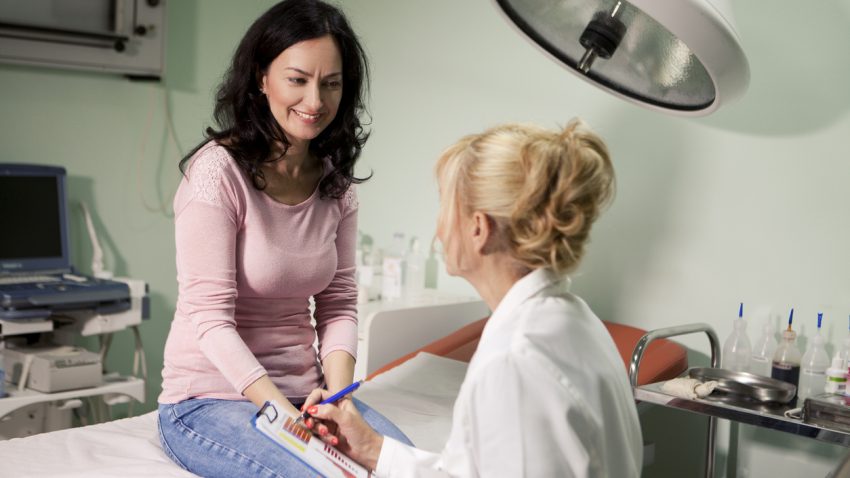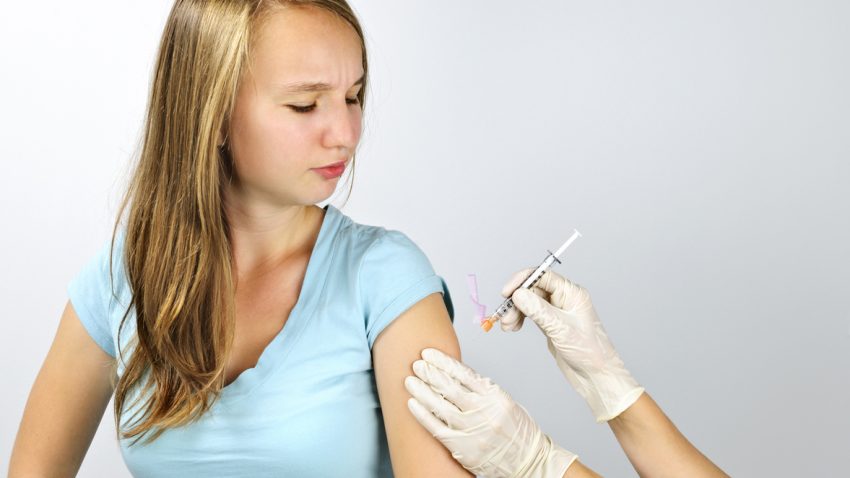

Cervical Health Awareness Month: How You Can Be Proactive About Cervical Health
Did you know that over 11,000 American women are diagnosed with cervical cancer every year? What about the fact that an estimated 79 million Americans are infected with the human papillomavirus (HPV), many of whom don’t know they have the virus?[1]
In honor of Cervical Health Awareness Month, let’s take the time to unpack what it means to tend to cervical health. There’s a lot that women can do to protect themselves from HPV, which is one of the main causes of cervical cancer. While most of us have heard of cervical health, many Americans are still uninformed about the details and risks surrounding cervical health.
What is Cervical Cancer?
The cervix is the name for the lower, narrower portion of the uterus. It links the vagina to the upper section of the uterus. Much like any other kinds of cancer, cervical cancer begins when cells start to grow out of control. In this instance, it’s the cells lining the cervix that are affected. It is estimated that in 2017, there will be 12,820 new cases of invasive cervical cancer and 4,210 women will die of the disease.[2]
Cervical cancer used to be one of the deadliest types of cancer for American women. However, over the past 40 years, thanks to a high uptake of Pap tests, this has ceased to be the case, with the death rate decreasing by over 50%. However, a recent study suggested that the death rate could be higher than previously thought, especially among black women. Previous calculations included women who had had their cervix surgically removed. These new figures take these women out of the equation, estimating that the death rate is more like 10.1 per 100,000 among black women, while among white women, it is 4.7 per 100,000.[3]
Although this latest study did not look into why there should be such a difference between races, it has been suggested that this could be down to problems with insurance coverage, difficulties in accessing Pap tests and not being able to follow up on abnormal test results.
The Pap (Papanicolaou) test is a quick and simple procedure that collects samples of cells from the cervix to test for any abnormalities, while the HPV test checks for the HPV virus that may cause cell changes. Though screening is demonstrably effective, 10% of American women in 2012 stated that they had not had any screening tests for at least five years. This means that every visit to your OB/GYN should be taken as a chance to discuss preventing cervical cancer.
This simple screening test detects changes in the cervix before cancer starts and can also spot cervical cancer early when it is easiest to treat and cure. Cervical pre-cancer is far more commonly diagnosed than invasive cervical cancer.
In addition to better screening services, there is increased support available now, which also contributes to survival rates.
Cervical cancer most frequently occurs in women aged 20-50, although over 15% of cases are in women aged over 65. However, if you have been having Pap tests regularly, you are unlikely to get cervical cancer in your sixties.

Cervical Health Awareness Month
The Truth About HPV
The human papillomavirus is the collective term for a group of over 150 viruses. Each HPV virus has its own number, or HPV type. HPV is responsible for a variety of ailments, including warts and various cancers, including cancer of the mouth or throat, penile HPV cancer and, of course, cervical cancer.
The virus is a sexually transmitted infection that is so virulent that almost every adult male and female will be infected by it at some stage in their lives. Latex condoms can reduce your chances of catching HPV, but not eliminate them completely, since HPV is spread through skin-to-skin contact rather than an exchange of fluids.
You can be a carrier of the virus without displaying any symptoms and when symptoms do develop – if they ever do – it can be years after the initial infection, making it difficult to pinpoint when you first caught the virus. In the majority of cases, your body will fight the virus off without any major consequences, but when this does not happen, you can develop serious health issues.[4]
What Increases the Risk of Developing Cervical Cancer?
There are many factors that contribute to the possibility of developing cervical cancer, including:
- Changes in your lifecycle
- A weakened immune system
- Infection by the HPV virus
- Smoking
- Stress
- Diet
Your cervical cells are most likely to grow abnormally during puberty, your first pregnancy and in the weeks following the birth of a child. A Pap test involves taking cells from the part of the cervix where cells from the vagina meet other cells from the uterus, an area known as the squamo-columnar junction. Normally, this junction is high where the cells are protected but at these transitional times, the junction lowers and goes further into the vagina, making it vulnerable. This may also be the case for younger women, particularly teenagers.
If you want to stay as healthy as possible, reduce or remove any harmful factors that may be impacting on your body’s defense systems. Although regular Pap smears are an important aspect of maintaining cervical health, it is worth remembering that these tests are only for screening purposes. They will pick up any abnormal signs, but cannot prevent cervical cancer from developing, so you need to make sure you maintain as healthy a lifestyle as possible. Simple changes such as including more fresh fruit and vegetables in your diet can make a huge difference.
To minimize your chance of contracting HPV, practice safe sex at all times and ensure that your pre-teen sons and daughters get the HPV vaccine. Young women and men should also be vaccinated, since men can pass HPV to women. If you’re unsure whether you should be vaccinated, speak to your healthcare professional.
Preventing Cervical Cancer
Not only have there been great strides in reducing the rate of death from cervical cancer, it is also one of the most preventable female cancers. While the HPV vaccination may prevent infection with the HPV types responsible for most cervical cancers, screening still plays a vital role in identifying changes in cervical cells so that cancer can be stopped before it develops.
Over 50% of all new cases of cervical cancer are among women who have either not been screened during the past five years or have never had any screening test. Yet approximately 7 out of 10 women who haven’t been screened in the past five years are under the care of a regular doctor and have health insurance. This makes it even more crucial that medical professionals persuade their patients to come in for regular screening.
If women and their healthcare professionals work together, we can make a big difference to diagnosis and survival rates.

HPV vaccination
What Can Medical Professionals Do?
When women visit their doctor or nurse, give them information about the screening tests. Include details about which ones are most appropriate for their personal circumstances and how frequently they should be screened. When a woman has been for a screening test, they should get their results through as quickly as possible, with any necessary follow-up care scheduled as a priority.
Medical professionals should also implement reminder recall systems so that doctors, nurses and patients are all aware when screening tests are due. In addition, you should recommend that preteens and teens receive vaccinations against HPV. In 2013, only a third of girls and a seventh of boys had received the recommended three doses of the HPV vaccine.[5]
What Can Women Do?
Women should educate themselves about the various screening options available so they can make sure that they get the most appropriate tests and then follow-up on any abnormal results. Ask your OB/GYN for more information or contact your local health department to learn how you can get screened.
When you have a health care visit, ask when you should next be screened. All women aged between 21 and 65 are advised to have regular Pap tests. If the results from your tests come back normal, your doctor may recommend that you wait three years until you are tested again. However, if you notice any signs or symptoms that are abnormal for you, don’t be afraid to go back to your doctor before then.
If you are 30 or older, you may be offered an HPV test at the same time as your Pap test. This is called co-testing. If the results of both these tests are normal, you have a very low risk of developing cervical cancer and may be told that you can wait up to five years before retesting.
Make sure you do not arrange your Pap test during your period – this will affect the results. For the two days before your Pap test, you should also avoid douching, using tampons or any type of internal medicine or cream. You should also abstain from sex and not use any birth control foam, cream or jelly.
During your Pap test, your doctor may decide to carry out an additional pelvic exam to check your uterus, ovaries and other organs. It is important to be aware that Pap tests only screen for cervical cancer and not for any other types of cancer, such as ovarian or uterine.
It is crucial that you continue to have Pap tests according to your doctor’s recommended schedule, even if you believe you are past childbearing age or are no longer having sex, since it can take many years for symptoms to develop after you’ve been infected with HPV. However, if you are over 65 years of age and with no abnormal Pap test results for many years, or if you have had your cervix surgically removed, your healthcare professional may decide that you do not require any more Pap tests.[6]
Many of the women who are diagnosed with cervical cancer have never had a Pap test, which makes it even more important to have these lifesaving tests.
Book Your Test Today!
If you haven’t had a Pap test recently or you have any concerns about cervical health, make an appointment to speak to your doctor. They can advise you on the steps you can take to maintain good cervical health and make sure that you’re up to date on all your screening tests. Share this article with your friends and family and remind them to get screened. If you’re a medical professional, reach out to your patients who are due for their Pap test and encourage them to come in for screening.
Cervical health isn’t just a female issue either. Cervical cancer impacts on loved ones as well. Organizations such as Planned Parenthood make it possible for women to safely receive Pap tests, so if you or a close friend or relative cannot or do not want to go to your OB/GYN, alternatives are available.
Whatever you choose to do to show your support, make cervical health your priority in January.
What are you going to do for Cervical Health Awareness Month? As a healthcare professional, what can you do to encourage patients to make cervical health a priority? If you haven’t been screened for a long time, what’s been stopping you making that appointment and what would encourage you to get tested? We’d love to hear your thoughts in the comments.
Sources:
[1] https://healthfinder.gov/NHO/JanuaryToolkit.aspx
[2] http://www.cancer.org/cancer/cervical-cancer/about/key-statistics.html
[3] http://onlinelibrary.wiley.com/doi/10.1002/cncr.30507/full
[4] https://www.nytimes.com/2017/01/23/health/cervical-cancer-united-states-death-toll.html?emc=edit_nn_20170123&nl=morning-briefing&nlid=77775427&te=1&_r=1
[5] https://www.cdc.gov/hpv/parents/whatishpv.html
[6] https://www.cdc.gov/vitalsigns/cervical-cancer/


One thought on “Cervical Health Awareness Month: How You Can Be Proactive About Cervical Health”
Comments are closed.